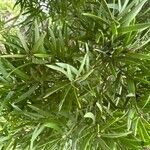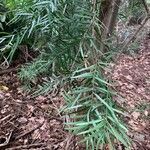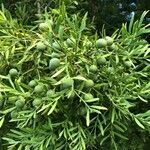A large evergreen tree. It grows to 30 m tall. Often in cultivation it is 15 m high. The trunk is tall and straight. The crown is spreading and rounded. The bark is light brown tinged grey. It peels in fine plates. The leaves are spirally arranged around the stem. The leaves are alternate and simple. They are narrow and sickle shaped. They are 3-5 cm long by 3-5 mm wide. Trees are separately male and female. It has fleshy male and female cones carried on separate trees. The male cones are in the axils of leaves and 10 mm long by 3 mm wide. The female cones do not have a fleshy receptacle. The fruit are about 18 mm across. The seed are round and 15 mm across. They are yellow.
Monoecious, evergreen tree, 10-35(-45) m high; bark brown, smooth or narrowly longitudinally fissured, flaking or adhering, forming plate-like scales. Buds glabrous, pointed, slender, sessile. Twigs glabrous, stout, dull, brown or green. Stems square or round. Leaves alternate, simple, sessile. Blade (10-)20-40(-45) x (1.2-)2.0-4.0(-6.0) mm, linear, lanceolate, elliptical or oblong, apex acute, base cuneate or truncate. Cones axillary, erect. Fruiting cones fleshy, glabrous, (12-)13-17(-20) x 15-20 mm, roundish, smooth, relatively thin, leathery, yellow or green.
Tall tree, up to 25 m high. Branchlets usually less than 1.5 mm in diameter near apex. Leaf blade orientated in a vertical plane. Seeds borne on scaly or leafy branches, which do not swell, ripening to a yellowish or light reddish brown colour.
Dioecious, tall tree, 20-60 m. Leaves narrowly lanceolate to linear-elliptic, twisted at base, 20-40 x 2-6 mm. Seeds borne on scaly or leafy stalks, yellow to brown, without a fleshy arillode.





